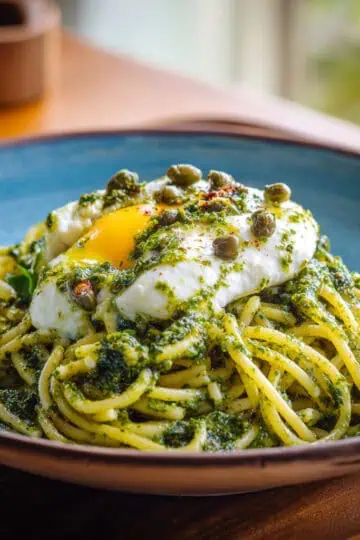Welcome to my Kusina Secrets! Today I'm sharing one of my family's absolute favorite dishes - Ginataang Tilapia. This is a treasured Filipino recipe that combines crispy fried fish with rich, creamy coconut milk, fresh spinach, and aromatic spices. I discovered this recipe years ago and have perfected it over countless family dinners.
The combination of the slightly crispy fish with the velvety coconut sauce is truly magical! The first time I made this, my family literally cleaned their plates and asked for seconds. It's become our go-to comfort food for both weeknight dinners and special occasions.
The best part? It's actually quite simple to make despite its impressive flavor. Let me show you how to bring these authentic Filipino flavors to your own table.
Jump to:
Why You'll Love This Recipe
- Perfectly balanced flavors - The creaminess of coconut milk beautifully complements the savory fish and subtle heat from peppers
- Impressive yet simple - Looks and tastes like restaurant-quality food with minimal effort
- Nutritious complete meal - Protein-rich fish paired with vitamin-packed spinach makes for a well-rounded dinner
- Authentic Filipino cuisine - Experience traditional Southeast Asian flavors in your own kitchen
- Customizable - Easily adapt with different fish varieties or vegetables based on what you have available
Ingredients
I carefully selected these ingredients to create a perfectly balanced dish. The tilapia provides a mild, flaky protein that beautifully absorbs flavors. Coconut milk creates the creamy base while garlic, onion, and ginger form the aromatic foundation.
The green peppers and optional Thai chilies add just the right amount of heat without overpowering. Fish sauce delivers that umami depth that salt alone can't achieve. Fresh spinach not only adds nutrition but also a pop of color and slight earthiness that completes this authentic Filipino dish.

- 2 whole tilapia fish, cleaned and scored on both sides
- 2 cups coconut milk
- 4 cloves garlic, crushed
- 1 medium onion, chopped
- 1 thumb-sized piece ginger, cut into thin strips
- 2 long green peppers, sliced
- 2 Thai chili peppers (optional, for heat)
- 2 tablespoons fish sauce (patis)
- ¼ teaspoon ground black pepper
- 2 cups fresh spinach
- 3 tablespoons cooking oil
- Salt for seasoning fish
Equipment
- Large frying pan or skillet
- Deep cooking pot
- Splatter screen (for frying fish)
- Wire rack or paper towels (for draining fried fish)
- Sharp knife
- Cutting board
- Wooden spoon or spatula
- Measuring cups and spoons

How To Make
- Season the fish - Rub salt all over the tilapia, including inside the cavity. Score both sides of the fish to allow better seasoning penetration. Let sit for 10 minutes.
- Fry the fish - Heat cooking oil in a large pan over medium-high heat. Carefully place the tilapia in the hot oil and fry until golden brown, about 5-7 minutes per side. Remove and place on a wire rack to drain excess oil.
- Prepare the base - In a deep cooking pot, heat 1 tablespoon of oil. Sauté the onion, garlic, and ginger until fragrant and the onion becomes translucent, about 2-3 minutes.
- Add coconut milk - Pour the coconut milk into the pot with the aromatics. Bring to a gentle boil, then reduce heat to medium-low. Cover and simmer for 5 minutes.
- Cook the fish - Add the Thai chili peppers and carefully place the fried tilapia into the coconut milk mixture. Cover and simmer for 12 minutes, allowing the fish to absorb the flavors.
- Add peppers and seasoning - Add the sliced long green peppers, fish sauce, and ground black pepper. Stir gently to avoid breaking the fish. Cook for an additional 3 minutes.
- Finish with spinach - Add the fresh spinach to the pot. Cover and cook for just 1 minute until the spinach wilts but remains bright green.
- Serve - Carefully transfer the fish and sauce to a serving dish. Serve hot with steamed rice.

Tips from Lola's Kitchen
- For crispier fish: Make sure your oil is properly heated before adding the fish. Test by dropping a small piece of onion – if it sizzles immediately, the oil is ready.
- For richer flavor: Let the dish rest covered for 5-10 minutes after cooking. This allows the flavors to meld together beautifully.
- Scoring technique: When scoring the fish, make diagonal cuts about ½-inch deep on both sides. This helps the fish cook evenly and absorb more flavors.
- Oil splatter prevention: Pat the fish dry with paper towels before frying to minimize oil splatter.
- Coconut milk tip: If using canned coconut milk, shake well before opening to ensure the cream and liquid are properly mixed.
Substitutions
- Fish options: Red snapper, mackerel, or sea bass work wonderfully in place of tilapia.
- Vegetable alternatives: Replace spinach with malunggay leaves (moringa), bok choy, or mustard greens for authentic Filipino variations.
- No fish sauce? Substitute with 1-2 tablespoons of soy sauce plus a pinch of salt.
- Pepper substitutes: Banana peppers or jalapeños can replace the long green peppers.
- Coconut milk alternatives: In a pinch, you can use 1½ cups of heavy cream mixed with ½ cup water and a teaspoon of coconut extract.
Troubleshooting
- Too fishy taste? Add a tablespoon of fresh lemon juice or vinegar to reduce fishiness.
- Sauce too thin? Simmer uncovered for a few extra minutes to reduce and thicken.
- Sauce too thick? Add ¼ cup water or chicken broth to reach desired consistency.
- Fish breaking apart? Handle the fish minimally once in the sauce, and use a wide spatula when turning.
- Not enough flavor? Adjust with additional fish sauce, a pinch of salt, or a dash of ground pepper.
Storage & Reheating
- Refrigeration: Store leftovers in an airtight container for up to 2 days.
- Freezing: Not recommended as the texture of fish and vegetables will deteriorate.
- Reheating: Gently warm in a covered pan over low heat until just heated through. Add a splash of water if needed to loosen the sauce.
- Next-day enhancement: Add fresh spinach when reheating to brighten up leftover servings.

FAQ
Can I use fish fillets instead of whole fish?
Yes! Tilapia fillets work well and require less cooking time (about 5-7 minutes in the coconut milk).
Is this dish spicy?
The spice level is adjustable. For mild flavor, omit the Thai chilies. For extra heat, add more or leave the seeds in.
Can I make this with frozen fish?
Yes, just ensure it's completely thawed and patted dry before frying.
Can I add other vegetables?
Absolutely! Eggplant, okra, or bell peppers make excellent additions.
What's the best way to serve this dish?
Traditionally served with steamed white rice, but it also pairs beautifully with garlic rice or crusty bread for dipping in the sauce.
Can I make this dish ahead of time?
For best results, serve immediately. However, you can prepare the components separately (fry the fish, prepare the coconut base) and combine them just before serving.
Is this recipe keto-friendly?
Yes! This dish is naturally low in carbohydrates and high in healthy fats, making it suitable for keto diets when served without rice.
What makes the sauce creamier?
Using full-fat coconut milk and simmering at a low temperature prevents separation and ensures maximum creaminess.
Related
Looking for other recipes like this? Try these:

Ginataang Tilapia (Filipino Coconut Milk Fish Stew
Ingredients
- 2 whole tilapia fish cleaned and scored on both sides
- 2 cups coconut milk
- 4 cloves garlic crushed
- 1 medium onion chopped
- 1 thumb-sized piece ginger cut into thin strips
- 2 long green peppers sliced
- 2 Thai chili peppers optional, for heat
- 2 tablespoons fish sauce patis
- ¼ teaspoon ground black pepper
- 2 cups fresh spinach
- 3 tablespoons cooking oil
- Salt for seasoning fish
Instructions
- Season the fish - Rub salt all over the tilapia, including inside the cavity. Score both sides of the fish to allow better seasoning penetration. Let sit for 10 minutes.
- Fry the fish - Heat cooking oil in a large pan over medium-high heat. Carefully place the tilapia in the hot oil and fry until golden brown, about 5-7 minutes per side. Remove and place on a wire rack to drain excess oil.
- Prepare the base - In a deep cooking pot, heat 1 tablespoon of oil. Sauté the onion, garlic, and ginger until fragrant and the onion becomes translucent, about 2-3 minutes.
- Add coconut milk - Pour the coconut milk into the pot with the aromatics. Bring to a gentle boil, then reduce heat to medium-low. Cover and simmer for 5 minutes.
- Cook the fish - Add the Thai chili peppers and carefully place the fried tilapia into the coconut milk mixture. Cover and simmer for 12 minutes, allowing the fish to absorb the flavors.
- Add peppers and seasoning - Add the sliced long green peppers, fish sauce, and ground black pepper. Stir gently to avoid breaking the fish. Cook for an additional 3 minutes.
- Finish with spinach - Add the fresh spinach to the pot. Cover and cook for just 1 minute until the spinach wilts but remains bright green.
- Serve - Carefully transfer the fish and sauce to a serving dish. Serve hot with steamed rice.
Tips from Lola's Kitchen
- For crispier fish: Make sure your oil is properly heated before adding the fish. Test by dropping a small piece of onion – if it sizzles immediately, the oil is ready.
- For richer flavor: Let the dish rest covered for 5-10 minutes after cooking. This allows the flavors to meld together beautifully.
- Scoring technique: When scoring the fish, make diagonal cuts about ½-inch deep on both sides. This helps the fish cook evenly and absorb more flavors.
- Oil splatter prevention: Pat the fish dry with paper towels before frying to minimize oil splatter.
- Coconut milk tip: If using canned coconut milk, shake well before opening to ensure the cream and liquid are properly mixed.
The Story Behind Ginataang Tilapia
Growing up in a Filipino household, I learned early that cooking with coconut milk ("gata" in Tagalog) is one of the cornerstones of our cuisine. Ginataang Tilapia, which literally means "tilapia cooked in coconut milk," represents the beautiful simplicity of Filipino home cooking that has been passed down through generations.
This dish has humble origins in the coastal regions of the Philippines, where fresh fish and coconut trees are abundant. Fishing communities would combine their daily catch with coconut milk harvested from nearby palms to create nourishing, flavorful meals. What began as practical cooking using available ingredients evolved into a beloved comfort food across the Philippine archipelago.
Tilapia itself has an interesting history in Filipino cuisine. While not native to the Philippines, tilapia was introduced to the country in the 1950s as part of food security initiatives. The fish adapted remarkably well to the local environment and quickly became a staple protein source for many Filipino families due to its affordability and mild flavor that pairs beautifully with bold ingredients.
The "ginataan" cooking method dates back centuries in Philippine culinary tradition. Long before modern conveniences, Filipinos would extract coconut cream by hand, grating coconut meat and squeezing it through cloth to produce the rich, creamy liquid that gives this dish its signature flavor. Today, while canned coconut milk offers convenience, many Filipino families still prefer fresh coconut milk for its superior taste.
What makes Ginataang Tilapia special among the many coconut-based Filipino dishes is its perfect balance of flavors. The natural sweetness of coconut milk is complemented by savory fish sauce (patis), while aromatics like ginger, garlic, and onions add depth. The addition of green chilies provides just enough heat to enhance rather than overpower the dish.
In Filipino culture, Ginataang Tilapia isn't just food—it's a representation of our resourcefulness and ability to create extraordinary flavors from ordinary ingredients. It's commonly served during family gatherings or Sunday lunches, when families come together to share not just a meal but also stories and laughter around the table.
Regional variations exist throughout the Philippines, with some areas adding a splash of vinegar for tanginess, others incorporating vegetables like eggplant or okra, and coastal regions sometimes substituting tilapia with whatever fish was caught that day. Each family tends to have their own version, tweaked through generations to suit their particular taste preferences.
My own recipe combines traditional techniques I learned from my grandmother with a few modern adaptations to create a dish that honors our culinary heritage while fitting into today's busy lifestyle. The result is a creamy, aromatic, slightly spicy fish stew that transports me back to childhood with every bite, and now I'm sharing it with you.










Comments
No Comments